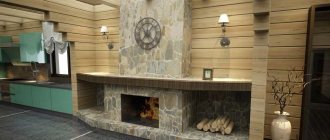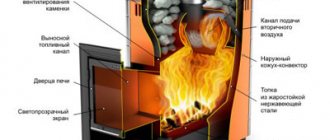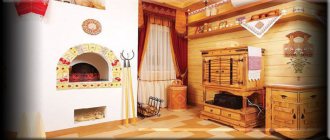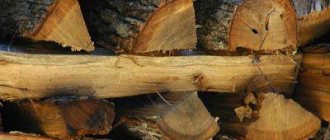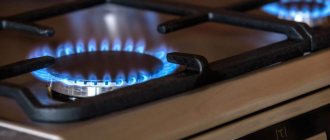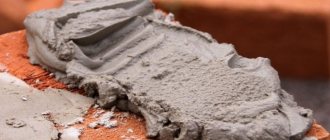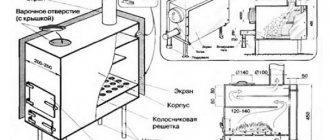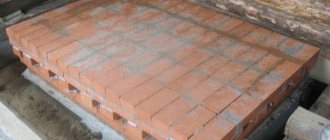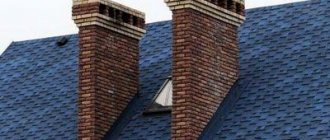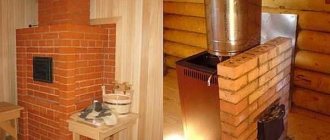Furnace departments
Any stove, be it Russian, Dutch, Swedish or a sauna structure, consists of several main sections. For each of them, the material should be selected separately, since certain characteristics required specifically for a specific part of the hearth are important.
Foundation
The first step is to build the foundation. Since the structure is usually located on the ground floor, the proximity of the ground must be taken into account. Therefore, a concrete slab is usually laid as the first layer, below the floor level, and a layer of waterproofing is applied to it.
Thus, we get a layer that will withstand the mass of our future structure, and also will not allow moisture and cold that come from the soil to affect it. Solid brick rows are usually laid on top of the waterproofing layer; there can be from two to four.
This is the second part of our foundation. As a rule, clinker material is used for it. This is due to the fact that it has very high strength, it is not afraid of loads, so such a base will easily support the weight of the entire stove.
Firebox
Another section of the design that raises the most questions about the selection of material is the firebox. This is the very place where firewood is laid and where the fire is made. The bricks in the firebox are directly exposed to the flame for a long time, and this happens over many years. Therefore, appropriate requirements are imposed on them.
As a rule, fireclay blocks are used to lay out the firebox. They have the highest fire resistance of all possible options, so they quietly perform their functions throughout the entire life of the fireplace.
In principle, the entire structure can be assembled from fireclay. But this is very expensive. In addition, the firebox lined with cream-colored fireclay blocks looks very advantageous when surrounded by red brick blocks, so this solution is optimal from the point of view of not only functionality, but also design.
Chimney and pipe
The chimney does not come into direct contact with the fire and does not carry a particularly high load. However, it also has certain requirements.
Firstly, it is exposed from the inside to aggressive chemicals released during combustion.
They have a detrimental effect on the condition of the building material from which the inside of the chimney is lined, so special attention should be paid to the stability of these bricks in various destructive factors
Secondly, the part of the chimney that is located above the surface of the roof of the house - that is, the pipe - is also subject to attacks from the external environment. Rain and snow, frost, wind, sudden changes in air temperature - all this significantly undermines brick blocks.
Experienced craftsmen recommend using two different materials for this section of the oven. Clinker, as the most resistant to aggressive chemicals, is used for laying out the inner layer. And on the outside, ordinary ceramic bricks are perfect, as they withstand the effects of the external environment very well. It’s not for nothing that many different structures are erected from it, including residential buildings.
Foundation Foundation
A Dutch oven, despite its light weight, needs a foundation. You can equip the foundation in two ways - from cement mortar or from bricks. Both options have their own characteristics.
In turn, a Dutch brick foundation will be noticeably more expensive, but at the same time it is much easier to make.
Formation of a cement foundation
Let's consider a method for forming a cement foundation for a Dutch oven.
You need to do the following:
- Prepare a pit, the depth of which is at least 50 cm. The area of the formed base must be larger than the size of the planned furnace.
- Make a cushion of gravel 10-1 cm thick and carefully compact it.
- Install the formwork and place a reinforcing frame made of metal rods, the thickness of which is 1 cm.
- Prepare the cement mixture and gradually pour the reinforcing structure.
- Cover the foundation with cement powder.
And now the solution.
High-quality masonry of a Dutch oven with a stove requires the preparation of a clay mortar. The strength and heat resistance of the Dutch oven and its tightness during operation depend on the quality of the solution.
The ratio of binding elements in the clay mortar depends on its purpose:
- for masonry work or
- for finishing a stove with a stove.
The frozen mixture must have a high level of rigidity. Masonry mortar of the correct consistency will be plastic and viscous, it will not crumble and will not be liquid.
Preparation of masonry mortar.
This process includes the following steps:
- The clay is placed in a trough where some water is added to it.
- After this, the clay soaks for 6-48 hours.
- While the clay is soaking, the material is thoroughly mixed and, if necessary, trampled in rubber boots.
- Sifted sand is added to the solution.
Now that the preparations are complete, you can begin laying the Dutch oven and stove.
Type of material for the project
Scheme of laying furnace rows.
The outer layer of the project is usually made of ceramic bricks. This material is easy to process and has sufficient thermal conductivity.
When purchasing, carefully inspect its surface. High-quality stones of this type have no differences in color over the entire surface, there are no cracks or chips, and the geometry meets the standards.
The furnace firebox requires special refractory bricks that can withstand high temperatures and are highly durable. The latter property is both an advantage and at the same time a disadvantage, since it complicates its mechanical processing.
Refractory bricks are made in various forms. Moreover, it has no voids. This type of artificial stone can withstand temperatures of +1400… +1600 ºС. It differs from the usual type in its composition and characteristic metallic ringing when struck.
It is made from special refractory clay in industrial ovens at very high temperatures. This material has clear edges, which makes it possible to make precise geometric structures from it. But refractory bricks have a fairly high cost. Therefore, it is recommended to divide the building into external and internal decoration.
This allows you to significantly reduce project costs without compromising its safety and thermal conductivity.
Now regarding the calculation of the number of bricks when laying a heater
You need to realize that the heater experiences no less temperature loads than the firebox, so for interior decoration we use only fireclay (fire-resistant) bricks. As a solution for binding layers, it is best to use a special mixture for masonry with fire-resistant and vapor-repellent properties (it is usually easy to buy in a specialized store).
Fireclay bricks are placed on edge for laying walls, and flat on the base and roof. The exception is an open heater; it does not have a ceiling vault. Between the fireclay bricks on the walls of the heater and the brick wall, 5 mm thick basalt cardboard is laid (the fact is that fireclay bricks have a higher coefficient of linear expansion than ordinary ones, and basalt cardboard, in addition to its heat-insulating properties, also plays the role of a damper pad).
The general formula for calculating the minimum volume of a heater for a steam room:
- steam room from 12 – 15 cubic meters. meters – heater 55 – 75 cubic meters. decimeters - 25 fireclay bricks and 30 M - 250;
- steam room from 15 – 25 cubic meters. meters – heater 75 – 100 cubic meters. decimeters - 35 fireclay bricks and 40 M - 250;
- steam room from 25 – 35 cubic meters meters – heater 100 – 120 cubic meters. decimeters - 40 fireclay bricks and 50 M - 250;
Larger steam rooms require the installation of special convection chambers for better heating throughout the entire volume, and this is a topic for a separate answer.
sdelaikamin.ru
Calculation of furnace dimensions
The stove planned for construction should provide a comfortable temperature in the house. To calculate the size of the furnace, you first need to know the heat loss of the building. This can be done mathematically and experimentally. Let's take a closer look at the second method:
There should be no sun outside and a strong wind is desirable. All electrical and heating equipment in the house must be turned off. Windows, doors and ventilation must be properly closed. After 24 hours, you need to take the reading of the room thermometer.
We turn on the electric heater with a power of 1 kW. After 24 hours, you need to record the temperature again.
The experiment can be carried out at any time of the year. The main thing is that there is no sun, which will give a large error. Find the average temperature with and without a heater. We calculate their difference and divide by the set power of the heating device. The resulting number indicates how many degrees a 1 kW heater adds.
Let's determine the comfortable temperature in the room. We find the difference between the desired room temperature and the minimum outdoor temperature in winter. We divide the result by the value obtained earlier. You will get the power needed to heat the house.
Preparing for the installation of the furnace
Before installing the stove, you need to carry out a number of preparatory work:
If a gas main is connected to the house, then the location of the stove must be coordinated with the gas and fire service so that the structure can be used absolutely legally
In addition to the location, you also need to pay attention to the features of the stove - for example, it can be built into a wall or located in close proximity to flammable materials. For the stove it is necessary to calculate and make a separate foundation. The perimeter of the foundation should protrude beyond the contours of the stove by at least 5 cm on each side
To fill the foundation, you can use either reinforced concrete or ordinary sand-lime brick. In the latter case, the foundation rows must be reinforced with mesh so that the structures do not deform. The soil under the foundation must be well compacted, and a sand cushion at least 5 cm thick must be placed on it. The room must have high-quality ventilation. Even if gas is not supplied to the house, ventilation is still needed - thanks to it, the stove will have good draft. The lack of high-quality ventilation causes a vacuum to appear in the room, due to which the stove “pops” noticeably during operation.
Calculation of the amount of required materials
The easiest way to calculate materials is to hire specialists who will select and provide you with a choice of a suitable stove design, in which all costs are calculated, down to the last brick. A project suitable specifically for your home, with an individual arrangement of walls and roof. If you decide to build a stove yourself, you will encounter a lot of problems in calculations, the correct location of the stove, compliance with fire safety, the appropriate choice of chimney, calculation of the depth and design of the foundation, and if you have never laid brick, you will not be able to lay out the stove beautifully , with straight seams, uniform stitching. If you are confident in your abilities and construction skills, you will be able to build your own stove, having previously studied a lot of important information on the technology of stove laying and fire-prevention cutting.
Preliminary work
- If your home has natural gas, you will need to coordinate the location of the furnace with the gas and fire departments and obtain all the necessary documents and seals. Since the stove can be built into a wall or adjacent to it, it is located in a fire hazardous proximity to wooden walls and wooden roofing elements.
- Depending on the mass of the furnace, calculate the size and load-bearing capacity of the foundation. The foundation is the basis of absolutely any oven. It should be emphasized that the perimeter of the foundation must exceed the perimeter of the stove itself by at least 5 cm on each side. The foundation can either be poured with concrete mortar, with mandatory reinforcement, or laid out from ordinary sand-lime brick. The foundation rows are reinforced with masonry mesh to avoid deformation. A sand cushion, at least 5 cm thick, is installed under the base. The soil under the cushion is carefully compacted.
- Ventilation in the room is also a requirement of the fire department if you have natural gas. In addition, ventilation contributes to good draft in the oven, without “reverse pops”. Since the lack of air flow creates a vacuum in the room during operation.
Next, you will need to calculate the amount of materials. The most numerous of them is brick. Moreover, when constructing a stone oven, different types of bricks are used. To lay out the firebox or furnace, that is, in places of the highest heating, refractory clay brick (fireclay) is used, note that it has a rather high price, which is why it is used only in those places where it is necessary. For laying a chimney, the use of fireclay bricks is not advisable; it is more appropriate to use fireproof bricks; they do not have direct contact with fire, but can withstand temperatures of up to 1000 degrees. To install the outer part of the pipe, which is exposed to climatic aggression, frost-resistant brick is used; it is less susceptible to deformation from temperature changes, for example, sand-lime brick, which can crack under such conditions. Ceramic bricks, which have a beautiful appearance, are used for lining the stove.
An example of calculating the number of bricks
Let's look at a simple example of calculating a brick as a whole. Whatever the perimeter of the oven, the first row is laid out entirely, for example, 4 * 4 bricks. That is, the first row consists of 32 bricks. The number of rows depends on the height of the room; the height of a single brick according to GOST is 65 mm, plus 5 mm for the seam between the rows. We get the height of one row - 7 cm. For example, the height of the room is 2.8 meters, from this figure we subtract 0.3 meters for fireproof cutting, we get 2.5 meters. Divide the total height by the thickness of one row and we get 36 rows. 36 * 32 = 1152 bricks. Since the oven has hollow parts, we will subtract 1/3 from this figure. So, we need 768 bricks for a stove with a chimney. Next, we calculate the amount of bricks per chimney pipe, take a standard square pipe as a sample, one row of a standard pipe consists of 6 bricks, note that the pipe can be rectangular or even round, and this calculation method will not work, and by analogy with a stove, the required quantity is calculated number of pieces per pipe. The height of the pipe, for example, is 4 meters, it consists of 57 rows, the total number of bricks will be 342 bricks.
Next, we calculate how many pieces will be needed for cutting, it depends on the shape of the oven and its location; if it is built into a wooden wall, the thickness of the wall is taken into account. For example, a wall is one brick thick, the minimum cutting width is 25 cm, that is, on each side of the oven the cutting is laid out in one brick, 36 rows on both sides, we get 144 bricks. In the case where the furnace is not adjacent to the walls, cutting is done only in the areas adjacent to the ceiling and roof elements; in the standard case, from 30 to 50 pieces are required. You should also take into account the effect of broken bricks in pallets. Not less than 10 percent. It depends on the shipping method.
pechiexpert.ru
Calculation of the number of bricks
Regardless of the type of brick block, they all have the same standard dimensions. This makes it possible to use several varieties at once in one masonry, without having to rack your brains trying to align the rows.
Bricks have the following dimensions:
- single (standard) - 250x120x65 millimeters;
- one and a half - 250x120x88 millimeters;
- double - 250x120x138 millimeters.
There are also other options, but these are, as a rule, European standards that are not applied in our country.
For kiln construction, as a rule, single bricks are used, sometimes one-and-a-half bricks. Double is not suitable in this case. The fact is that it is usually hollow, that is, it has a large number of holes in the structure. This is done in order to reduce its weight.
We only need solid blocks. Hollow ones accumulate heat much worse and are destroyed more quickly under the influence of various aggressive factors.
Let's move on directly to the calculations. For them, we need only two indicators: the number of bricks from which the lowest continuous row is laid, that is, the base, and also the number of rows. All this is easy to calculate if you know the dimensions of the blocks you are going to use.
Having calculated the amount of material in the base, multiply it by the number of rows of which the oven will consist. In this case, only those departments that go up to the chimney are taken into account. Subtract a third from the resulting product, and you will have the required number of bricks.
We carry out calculations for the chimney separately. There you take the number of bricks in one row, multiply by the number of rows and do not subtract anything.
That's all. All that remains is to add up the results. Now you know how many bricks you will need to build a fireplace. Don't forget to add about 5% in case of replacing blocks broken during construction. Good luck and warmth in your home!
HOW TO CALCULATE THE REQUIRED OVEN SIZE?
This can be clearly illustrated by the example of lighting a room, especially since both heating and lighting involve energy, measured in watts. To illuminate the bathroom, a 60-watt light bulb is enough. For a medium-sized kitchen you will already need 100 watts. And for a decent living room you will need a chandelier with three 100 watts. Well, and vice versa, if we screw three hundred watts into the bathroom, then the sensations when using the room will not be the same, you must admit, after all, the bathroom is not the southern coast of Crimea.Like a lighting fixture, each stove has its own power, which is usually calculated based on the surface area of the stove (the bottom and top of the stove are usually not taken into account). Conventionally, it is assumed that 1 m2 of furnace emits 500 kW per hour during the day when the furnace is fired twice per day. Here I would like to point out that similar indicators for metal stoves have a different meaning - they show the number of watts generated not during the day, but only during operation of the device, and if you divide this by 24 hours, you will see that the indicated by the manufacturer of metal stoves, the power is not quite the same as the power of brick stoves (a kind of juggling with the concept of “power”).
But let's return to our ovens. For a stove with a base of 1 by 1 meter with a standard height of 2.1 m, the heat-transfer surface area will be equal to 4 * 2.1 = 8.4 m2, from which the power is equal to 8.4 * 500 Watt = 4200 W/h or 4.2 kW/h. I repeat that this means that this stove, when fired twice a day, produces 4.2 kW of thermal energy every hour.
How do you match this to your needs? To do this, you need to determine the amount of heat loss at home. It is best to contact an engineer or an experienced stove maker about this, since the amount of heat loss is influenced by many different factors: the material from which the walls and ceilings are made, its thickness, size, quantity and quality of windows and doors, and others. In the literature on furnaces there are many different tables and graphs from which you can try to determine heat loss yourself, but this is a very difficult task for a non-specialist, which can give an inaccurate result.
One of the simple ways to approximately determine the amount of heat loss is based on the fact that the value of 40 watts is taken as a conventional unit of heat loss for 1 m3 of an average room and, by multiplying it by the number of cubic meters of the room, the desired value is obtained. For example, it is necessary to build a stove for a house 6 by 6 m with a ceiling height of 2.6 m. Taking into account the thickness of the walls, the area of the room is 5.4 * 5.4 = 29.16 m2, hence the volume is 29.16 * 2.6 = 75.8 m3. Multiplying the resulting value by 40, we have approximately 3 kW/h, which is the approximate amount of heat loss in your home. To heat such a house you need a stove with a capacity of at least 3 kW/h. Based on the fact that 1 m2 of the stove produces 500 W/h, we find its surface area to be 6 m2. Dividing it by 2.1m (standard height) we get a little less than 3m, this is the length of the perimeter of the oven. The length of the side of the stove should be a multiple of the length of the brick or half its length (12 or 25 cm).
From here we find the possible lengths of the sides - 750 * 750mm, or 500 * 1000mm. To be safe, you can slightly increase one of the sides, say, by half a brick. If the stove is made less than necessary, then it will have to be used more, and it will quickly fail. If it is more, the furnace will operate with reduced efficiency. Once again, I would like to emphasize that the above calculations are approximate and for each specific case it is necessary to introduce your own amendments, so it is better to consult a specialist to make a final decision.
https://vk.com/kaminopechrf?w=wall217682097_79%2Fall
Dmitry Zatsarny
What types of stoves are there?
Diagram of a Dutch heating stove.
The classic Dutch model is purely heating. The rectangular model has a single brick wall. Subsequently, stoves appeared in the form of a triangle, trapezoid, and round shape.
They can be heating, with a fireplace, with a stove, or a tank for heating water. It's easy to create them yourself. You need to choose the appropriate option and get to work.
A small stove for a summer house will take up very little space. Its perimeter is about 50 cm. At the same time, it is capable of heating several not very large rooms. You can lay it out of ceramic bricks. For the manufacture of fireboxes, fireclay fireproof type is used.
A Dutch oven with a stove is a rather rare option; it is often used not only for heating, but also for cooking. It is easy to fold it with your own hands using solid ceramic bricks. For the firebox area - fireclay brick.
The three-turn stove is laid using red ceramic solid bricks. Fireclay is suitable for the firebox area.
The round stove was quite often used to heat hospital buildings and shelters, that is, where there was no money for full-fledged stoves. Usually it was laid out in one brick and covered with a steel casing on top. This Dutch oven seems simple, but is quite complex in execution, so it is better to entrust its manufacture to an experienced craftsman. It is unlikely that you will be able to lay it out yourself.
Diagram of a Dutch oven with a stove.
For a house in which people live constantly, it is necessary that the stove can store heat for a long time.
This largely depends on its mass and, ultimately, the amount of material spent on construction. The efficiency factor is important, on which its efficiency depends.
For a dacha where the owners only visit, the stove must heat up quickly. This is a lighter, more economical option that requires little material. The ideal option in such a case would be Dutch.
I'll answer the second part of the question first.
Indeed, many people ask a similar question when installing a stove in a bathhouse themselves. If you decide to build a sauna stove out of brick, then you cannot do without creating a solid foundation.
From the point of view of construction safety, it is necessary to remember one formula (most stove makers use it): for one ton of stove mass, a casting of 10 cm of reinforced concrete base is required. Calculating the total weight of the structure is quite simple: we multiply the number of bricks by 8 kg (the weight of one brick is M - 150 or M - 200) and add 15% to this figure (this is the weight of the mortar and additional stove devices - heaters, fittings, etc.) . Be sure to calculate the weight of the chimney, pipe and crown, which will also create additional load on the foundation.
Another additional factor that should be taken into account when casting a foundation for a brick kiln is the type of soil on which you will lay it. The fact is that if your sauna is used only periodically, the soil underneath will freeze, and, as a result, the foundation of the stove will experience seasonal soil fluctuations.
If the bathhouse is located on heavy clay soils (builders call such soils heaving), then ground vibrations will be significant. An incorrectly cast foundation may not compensate for soil movements and, as a result, the furnace may crack or completely collapse.
On such soil, a columnar foundation can be considered ideal. It is done this way:
- The area of the furnace base is measured and 10% is added to each edge of the foundation length.
- A fertile layer is selected to a total depth of 30-50 cm (a rare sauna stove will be more than five tons).
Pit for casting the foundation (the soils are light, so the foundation will be without additional reinforcement)
- At the corners of the pit and in the center of the site, with a drill hole with a diameter of 12-15 cm, holes are made to the depth of soil freezing in your area (even if you divert wastewater into a sewer, the groundwater, having nourished the soil layers, will cause the soil to swell in winter).
- The pits are vertically reinforced (possibly three rods, maybe four). The diameter of the reinforcement is at least 8 mm (fiberglass reinforcement can be up to 6 mm) and filled with concrete (standard concrete, grade M-400. If you do it yourself, use the formula: 1:3:1 - one part cement - three parts sand - one part gravel).
- After the concrete “sets” (48 hours after casting), we make a sand cushion at the bottom of the pit, the thickness of the cushion for casting is at least 5-7 cm. We carefully compact the cushion (many craftsmen use the “spilling” method instead of tamping - they pour water on the sand cushion and the sand itself is compacted to maximum shrinkage density).
- The walls of the pit are waterproofed with roofing felt or other material.
- Formwork with a height of at least 10 cm is placed above the ground.
- After this, the foundation is reinforced. You can use reinforcing bar, laying it at intervals of 10 cm (bar diameter is at least 6 mm), the second layer is perpendicular to the first, the screed is made by twisting wire or plastic clamps. Many stove makers use masonry mesh to reinforce the foundation (the mesh should be no more than 10 cm). Both the reinforcing bar and the masonry mesh are laid at a distance of 5 cm from the sand pad, as well as in layers every 10 cm of pouring the concrete pad.
Reinforcement of concrete with a masonry mesh with a mesh of 5 cm, such a mesh is laid every 10 cm of the casting, in order not to get lost, you can stick a metal rod with marks every 10 cm into the pit
- Concrete must be poured in one go (one work shift), this will avoid concrete delamination (it happens that in hot weather the layers set unevenly and as a result the concrete does not have the required strength).
It is best to use a concrete mixer when making concrete yourself.
- The total setting time of a concrete pad depends on its thickness. As a rule, laying the furnace base begins two weeks after casting the foundation, but first they make an iron corner trim along the upper edge of the concrete pad
The corner should be joined at an angle so that there are no vertical layers, the joints are boiled
If you intend to pour the foundation for a brick stove in a bathhouse, which will be built on light soils (sandy loam, sandy, etc.), then seasonal fluctuations in the soil are not so pronounced here, so the depth of casting the foundation is not tied to the depth of soil freezing. You just need to remove the fertile layer and make a depression in the soil equal to the thickness of your foundation, based on the total mass of the entire structure, and then use the algorithm of actions outlined above.
These, in principle, simple steps will allow you to be sure that the stove you installed in the bathhouse will last for a long time.
How to calculate the number of bricks
The amount of this material depends on the size of the Dutch oven. If there is a ready-made project, then, as a rule, the amount of building materials is indicated. Experienced furnace specialists also know how much material is required for a furnace of a given size. But if you plan to lay a Dutch oven with your own hands, there is a universal formula for counting the number of bricks. It should be noted that the quantity calculated here is also imprecise, conditional.
You should calculate the number of bricks required to lay out the bottom row, provided that they are laid solid. Then calculate how many rows you plan to lay out in height, taking into account that the height of one row is approximately 7 cm. Multiply these two numbers and subtract 1/3 from the result.
//www.youtube.com/watch?v=apKtactWkqo
Let's say the base of the stove measures 3 by 4 bricks. It turns out that there will be 24 pieces in the first continuous row. Then you need to calculate the height of the future furnace. If the height of the house inside from floor to ceiling is 2 m 40 cm, the cutting height must be subtracted from this number - approximately 30 cm. The result will be 2 m 10 cm. Taking into account the row height of 7 cm, the result will be 30 rows in height. Then you should subtract a third of this number. 30 divided by 3 equals 10. Subtract 10 from 30 to get 20 rows. Then you need to multiply 20 by 24. You get 480 pieces. It will take about 50 pieces to cut, in the end it turns out that for such a stove you will need 530 bricks.
The amount of material per pipe is calculated separately. 1 linear m of pipe contains approximately 14 rows. For example, one row of pipe consists of 6 bricks, 6 multiplied by 14, you get 84. This number of bricks contains 1 m of pipe. Let the length of the pipe be 4 m, then 84 is multiplied by 4, you get 336. The result is that you will need 336 pieces per pipe.
The formula is quite simple. Of course, the amount of material calculated is not exact. But at the same time, you can already estimate how many bricks will need to be purchased and how much it will cost.
The Dutch oven has a simple design, is light weight and fits perfectly into a small room. It does not require large financial costs. For your dacha, you can build a rocket stove out of brick.
//www.youtube.com/watch?v=I4up-2P_lkc
It heats up quickly and can heat a room a few hours after it is lit. However, this design also has disadvantages. Its efficiency is about 40%, so it is difficult to heat houses where people constantly live. If you don’t close the view after heating, the stove will quickly cool down; it has a small heat capacity, so it has to be fired up often. These properties make the Dutch oven the most suitable, economical option for heating a summer house, garden house and other premises where people do not live permanently.
Methods for calculating the amount of bricks for a kiln
Calculations are not the most difficult thing, but they require attentiveness, intelligence, accuracy and accuracy. Professionals often use a tape measure, plumb lines, levels, and certain rules to determine the amount of building stone, mortar and financial costs, but there are simple schemes for beginners. It's enough just to be friends with a calculator.
Return to contents
Method one
This method is based on a conditional formula: count the amount of material in the 1st continuous row, multiply by the number of rows in height (one row is approximately equal to 7 cm), subtract a third from the result. Let's assume that the base of the oven is 3x4. Then the first row will take 24 bricks. A building 2.4 meters high with a cut of 30 cm will have 20 rows: (240-30)/7 = 30-1/3 = 20. Multiplying by 24 bricks of the first row, we get the number 480. At least 50 will be needed for cutting. As a result, we have 530 pieces.
The basis for the calculation is to take the amount of material in the first continuous row.
It should be taken into account that a separate calculation is carried out for the pipe. If they usually take four linear meters, each with 14 rows, then in total such a structure requires 336 bricks (6 pieces per row). Summing up the results, we get 866 units of building material for a small stove. Based on this calculation, you can already plan a purchase of at least 5,000 rubles.
Return to contents
Method two
The formula is a little similar to the previous one, only at the last stage we do not subtract one third, but multiply the result by the filling factor (for heating stoves - 0.8, for a stove with a heating panel - 0.65). In a building measuring 90x90 cm, for the first row you will need 24.5 bricks, for 30 rows, multiplied by a stable indicator of 0.65, - 477.75 pieces. Round up to 480. On average, a four-sided chimney 4 m high takes 224 bricks (56 pcs./m). Plus 56 for cutting. The overall result is 760. You will have to spend a little more than 4,500 rubles on this stove.
Both methods of calculation are conditional. For a Russian stove, a “Dutch stove” (three-turn construction) and a stove with a stove, the calculation is carried out separately for each component.
Return to contents
Types of kiln bricks
Kiln bricks can be divided into three types:
- Quartz contains a small sand content.
- Fireclay is made from fireproof clay.
- The main one contains a lot of limestone-magnesia mass.
Refractory brick can withstand high temperatures for a long time.
It has high strength, which makes it difficult to machine. Fireclay clay is used in its production. Available in different forms, it does not have cavities or voids inside. A distinctive feature is a metallic ringing sound when you tap on it. When broken, it splits into large pieces without forming crumbs. Its resistance to high temperatures and chemicals makes it an ideal candidate for firebox lining. The outer layer of the stove can be made of ceramic bricks. It is not so resistant to high temperatures, but it also has some advantages: it is easy to process. It can be given any shape using a pickaxe. When choosing such a brick, you should carefully study its appearance: there should be no cracks, and the geometry should exactly repeat the standard. The shade of the product should not differ across the entire surface.
How many bricks do you need for a stove?
The Russian stove has long become famous throughout the globe. It has long been a symbol of Russian housing, it was multifunctional and, thanks to its widespread use, became a record holder in its class. Indeed, you could cook lunch on it, relax on a warm bed, and even wash yourself. It is still preserved and is used in some houses.
To build such a stove, you need to know how many bricks it will take. The material will be used for the foundation, stove and chimney.
Owners of country real estate and individual houses in the city are thinking about creating a warm brick stove. Anyone can build it without incredible effort and with minimal experience working with stone. However, most of all the master is concerned with the question of how many bricks are needed to complete this task and what is its market value.
Methods for calculating bricks for a stove
The required volume of building material must be calculated as accurately as possible without any room for error. Because the excess brick will lie like a dead weight on your side and will disappear over time. The flaw will pop up at the most inopportune moment, stalling the process and adding headaches about its acquisition and delivery.
There are several methods for calculating how much brick is needed to build a stove. However, before starting work, prepare the following tools: a construction tape, a plumb line, a trowel and a rule.
One of the most common calculation methods can be expressed by a simple formula, which allows you to almost immediately find out how many bricks are needed for a stove. One point must be remembered: the universality of the method conceals an error that should be taken into account.
The formula can be described as follows: take the number of bricks of the first (solid) row
and multiply by the number of rows. The height of one row is approximately 7 cm. You need to subtract ⅓ of the product. For clarity, we need to look at an example.
The oven has a size of 3x4 bricks. Therefore, the base will contain 24 pieces. We find out the height of the oven, in our case 2.4 m. We subtract 0.3 m from it for cutting and get 2.1 m. Dividing by the height of one row, we have 30 rows. Subtract 10 (a third) from this value and get 20 rows, which we multiply by the number of bricks in the base (24 pcs.). The result was 480 pieces, to which we return 50 for cutting and have a total of 530 pieces.
This calculation does not include the amount of bricks for the construction of the stove chimney; we will calculate it separately. The main parameter here is the height of the chimney and its cross-section. If we take a pipe with dimensions of 50x50 cm as a basis, then each row will consist of 6 bricks. One meter of pipe includes about 14 rows or 84 bricks.
Let's do the math using a specific example. A four-meter chimney will require 4x84 = 336 bricks to build. When calculating how many bricks are needed to build a stove using this formula, do not forget about its conventions.
Calculation of furnace dimensions
The stove planned for construction should provide a comfortable temperature in the house. To calculate the size of the furnace, you first need to know the heat loss of the building. This can be done mathematically and experimentally. Let's take a closer look at the second method:
There should be no sun outside and a strong wind is desirable. In the house you need to turn off all electrical and
heating equipment. Windows, doors and ventilation must be properly closed. After 24 hours, you need to take the reading of the room thermometer.
We turn on the electric heater with a power of 1 kW. After 24 hours, you need to record the temperature again.
The experiment can be carried out at any time of the year. The main thing is that there is no sun, which will give a large error. Find the average temperature with and without a heater. We calculate their difference and divide by the set power of the heating device. The resulting number indicates how many degrees a 1 kW heater adds.
Let's determine the comfortable temperature in the room. We find the difference between the desired room temperature and the minimum outdoor temperature in winter. We divide the result by the value obtained earlier. You will get the power needed to heat the house.
The operating principle of a brick stove is based on the accumulation of thermal energy from fuel combustion and its release into the room over time. This can be done using a simple formula: the mass of the furnace is equal to the product of the calculated power, the duration of maintaining the temperature from one firebox and the number 85.7.
Types of kiln bricks
Kiln bricks can be divided into three types:
- Quartz contains a small sand content.
- Fireclay is made from fireproof clay.
- The main one contains a lot of limestone-magnesia mass.
Refractory brick can withstand high temperatures for a long time. It has high strength, which makes it difficult to machine. Fireclay clay is used in its production. Available in different forms, it does not have cavities or voids inside. A distinctive feature is a metallic ringing sound when you tap on it. When broken, it splits into large pieces without forming crumbs. Its resistance to high temperatures and chemicals makes it an ideal candidate for firebox lining.
The outer layer of the stove can be made of ceramic bricks. It is not so resistant to high temperatures, but it also has some advantages: it is easy to process. It can be given any shape using a pickaxe. When choosing such a brick, you should carefully study its appearance: there should be no cracks, and the geometry should exactly repeat the standard. The shade of the product should not differ across the entire surface.
When you purchase ceramic bricks, look at its name. The old nomenclature called it “grade 1 red.” Modern technologies make it possible to give the product yellow and white shades.
Recommendations for choosing bricks
In order to purchase high-quality material that will not let you down even after several years of use, you should carefully approach the selection procedure. Simple tips will help you do this:
- The counterfeit contains foreign inclusions, such as individual pebbles or pieces of limestone.
- It is advisable to buy the entire amount of material at once from one manufacturer and one batch.
- Brick that was not fired has a pale appearance and deviations from standard dimensions.
- The listed recommendations will help you correctly select and calculate the material for laying the stove. The process itself will require not only high-quality materials, but also solid experience.
Now you know how many bricks are needed for the stove. It is not difficult to calculate the amount of stone needed to build a stove on your own. Errors can only occur in numbers that need to be double-checked several times. Construction work on the construction of a furnace requires not so much an exact amount of material as its good quality. There are a large number of seemingly similar materials on sale, but they all have different quality.
The described calculation methods are used only in cases where the work is planned to be carried out independently. Hired workers will perform all calculations using their own methods. Don’t be afraid to pick up a calculator and then go to the store and purchase the necessary materials in the required volume.
How many bricks to hang in grams
Let's consider one of the simple and popular calculation methods that allows you to quickly find out how much brick is needed to build a Dutch oven.
Formula
The following formula is used for calculation:
This formula uses the following parameters:
- B – planned furnace height;
- P – height of one row;
- O – the number of bricks in the first row.
Let's look at a clear example.
Let's say it is planned to build a Dutch house 2.4 m high, at the base of which there are 24 bricks. The height of one row is 7 cm (the thickness of one brick).
- Subtract 0.3 m from the planned oven height for cutting. Thus, after subtraction, 2.1 m remains.
- The resulting number should be divided by the height of one row, resulting in 30 rows.
- We multiply the resulting value by 2/3, that is, we subtract 10 rows.
- 20 rows remain.
- We multiply the resulting number of rows by the number of bricks in the base (24 pieces).
- We get 480 bricks.
- Let's add 50 bricks for cutting.
Arithmetically it looks like this:
The result is 530 bricks - the required number to build a thirty-row Dutch oven.
The number of bricks for the construction of the chimney is calculated separately. It is determined by the height and cross-section of the chimney. Therefore, the formula should be used:
The following parameters are used:
- Chd – number of rows in the chimney;
- N – the number of bricks in one row of the chimney.
These simple calculations will allow you to determine how many bricks will be needed to build a Dutch oven.
How many bricks do you need for a stove for a private home?
Increasingly, the layout of private and country houses, cottages and other buildings includes a brick oven. But how many bricks do you need for a home stove, and how can you accurately calculate the consumption for a particular structure and the volume of material? It is necessary to calculate so that the quantity is enough to lay the stove, and there is a minimum of excess materials. Almost anyone can build a brick oven without much effort; work experience does not play a special role here. However, any builder will initially be concerned with the question of how many bricks are needed to lay the project.
Before building a brick kiln, it is necessary to accurately calculate the number of bricks for masonry.
Calculation of brick volume
In terms of laying a stove, they usually indicate the required number of bricks, and many professional stove makers know this. But there are options in which you can easily calculate how much material is needed for any stove for any home.
To build a stove, you should know how much material will be spent on its construction, taking into account the fact that the consumption will be not only for the project, but also for the chimney with the foundation.
The calculation sequence will be as follows: multiply the amount of brick laid out completely in the first row by the height (number of rows), and then subtract 1/3 from the result obtained. This way you can make an accurate calculation of the amount of material for the project.
To make a more accurate calculation, you can use numerical data. Here's an example:
- The base is 3x4 bricks, which means the continuous row will be 24.
- The height is taken as the distance from the floor to the ceiling. This can be 2 m 40 cm. But approximately 30 cm should be subtracted from this height, taking into account the cutting height. In this case, 2 m 10 cm will remain.
- Knowing that the height of one row is 7 cm, you need to use the following formula: divide 210 by 7. We get 30 rows.
- Now 1/3 is subtracted from this number. As a result, 20 rows will remain.
- This number of rows is then multiplied by the base of 24 pieces, resulting in a total of 480 pieces. But you also need to remember about cutting, for which you will need 50 pieces. Total - 530 pieces.
Any stove has a pipe. If in the project it is brick, then it also needs to be calculated. In 1 m of pipe there are normally 14 rows, and in 1 row - 6 pieces. This means that you need to multiply 6 by 14. The result is 84. Now this value should be multiplied by the height of the pipe in meters, and we will get the required volume of the required building material. For example, we multiply 4 m of pipe by 84. The result is 336 bricks.
The obtained values are, of course, conditional. There will still be an error, but these numbers will give you an idea of the total number of bricks and allow you to plan future costs. When the volume of material has been calculated, you need to select its type.
Type of material for the project
The outer layer of the project is usually made of ceramic bricks. This material is easy to process and has sufficient thermal conductivity.
When purchasing, carefully inspect its surface. High-quality stones of this type have no differences in color over the entire surface, there are no cracks or chips, and the geometry meets the standards.
The furnace firebox requires special refractory bricks that can withstand high temperatures and are highly durable. The latter property is both an advantage and at the same time a disadvantage, since it complicates its mechanical processing.
Refractory bricks are made in various forms. Moreover, it has no voids. This type of artificial stone can withstand temperatures of +1400… +1600 ºС. It differs from the usual type in its composition and characteristic metallic ringing when struck.
It is made from special refractory clay in industrial ovens at very high temperatures. This material has clear edges, which makes it possible to make precise geometric structures from it. But refractory bricks have a fairly high cost. Therefore, it is recommended to divide the building into external and internal decoration.
This allows you to significantly reduce project costs without compromising its safety and thermal conductivity.
Recommendations for choosing bricks
In order to purchase high-quality material that will not let you down even after several years of use, you should carefully approach the selection procedure. Simple tips will help you do this:
- The counterfeit contains foreign inclusions, such as individual pebbles or pieces of limestone.
- It is advisable to buy the entire amount of material at once from one manufacturer and one batch.
- Brick that was not fired has a pale appearance and deviations from standard dimensions.
- The listed recommendations will help you correctly select and calculate the material for laying the stove. The process itself will require not only high-quality materials, but also solid experience.
Bottom line
Now you know how many bricks are needed for the stove. It is not difficult to calculate the amount of stone needed to build a stove on your own. Errors can only occur in numbers that need to be double-checked several times. Construction work on the construction of a furnace requires not so much an exact amount of material as its good quality. There are a large number of seemingly similar materials on sale, but they all have different quality.
The described calculation methods are used only in cases where the work is planned to be carried out independently. Hired workers will perform all calculations using their own methods. Don’t be afraid to pick up a calculator and then go to the store and purchase the necessary materials in the required volume.
